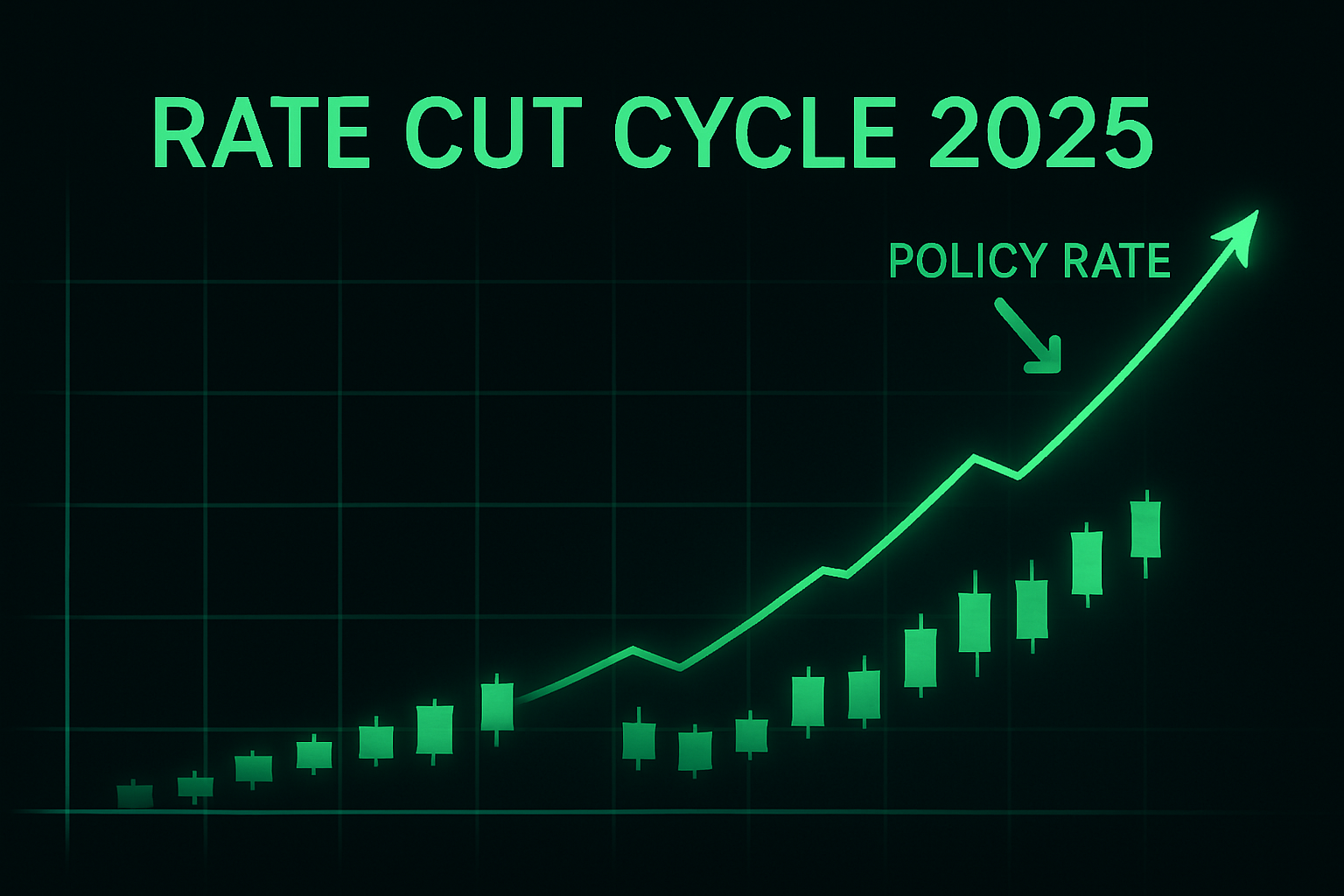Key takeaways
- Rate cut cycle 2025 is increasingly priced in by markets, with high odds of further Fed easing into year-end and a watchful pause from the ECB.
- Historically, the first 6–12 months after cuts see more liquidity and often higher equity returns—but with elevated volatility.
- Positioning often favors quality growth, select cyclicals, and the front/middle of the bond curve, while the USD can wobble if the Fed moves faster than peers.
Why a rate cut cycle in 2025?
After the fastest tightening in decades, disinflation and softer growth are pushing major central banks toward easing. In the U.S., traders currently assign very high odds to additional rate cuts into late 2025 as the labor market cools and policy normalizes. See current coverage and probabilities via Reuters. In Europe, the ECB delivered a series of reductions into mid-2025 and now signals a more data-dependent stance; a useful overview is in the European Parliament’s October 2025 brief here (PDF) and recent ECB communications covered by the Financial Times.
What history says (with a reality check)
Across past cycles since 1980, U.S. equities have typically posted positive 12-month returns after the first Fed cut, though the path was choppy. Northern Trust’s research shows strong average gains with higher volatility during the first year of easing—useful context for the rate cut cycle 2025. Read their analysis here.
But: not all cut cycles are bullish. If cuts arrive into a hard landing or profits recession, cyclicals can lag and defensives lead. Studies from Schroders suggest defensives often outperform right after the first cut, depending on macro conditions—see summary here.
Playbook: assets & tactics for 2025
1) Equities: lean into quality & rate-sensitives—selectively
- Quality growth with durable cash flows tends to benefit as discount rates fall.
- Rate-sensitives (homebuilders, some financials) can catch a bid when financing costs drop; see recent market color on sector reactions here.
- Defensives (staples, healthcare, utilities) may outperform if growth slows while cuts proceed (mixed/late-cycle regimes).
2) Bonds: extend duration—pragmatically
- Core duration: If the path of policy rates trends lower, adding to the belly of the curve can balance rate risk and carry. See portfolio implications discussions from BlackRock and iShares (insight, guide).
- Credit: Prefer higher-quality credit early in an easing cycle; widen into selective BBB/BB risk only if growth data hold up.
- Cash: Expect yields on money market funds to drift lower as policy eases; consider redeploying excess cash deliberately into a ladder or core bond sleeve.
3) FX: watch the USD vs. peers
- If the Fed cuts faster than the ECB/BoE, the USD can soften; conversely, global growth scares can boost safe-haven demand. Recent FX commentary notes the dollar’s sensitivity to the Fed’s path—see reporting here.
- EUR: With the ECB signaling flexibility but fewer near-term moves priced, relative policy could support EUR on dips if U.S. easing outpaces Europe.
- GBP: The BoE has been easing as inflation cooled; path dependency matters—see their explainer here.
4) Commodities & crypto: liquidity helps—but macro rules
- Gold tends to benefit if real yields fall and USD weakens.
- Oil is more about growth and supply; cuts help if they stabilize demand.
- Crypto can be liquidity-sensitive; higher risk appetite during easing is a tailwind, but volatility remains elevated.
Risk map for the rate cut cycle 2025
- Sticky services inflation could slow or pause cuts (ECB is already sounding flexible rather than committed).
- Data gaps / shocks (e.g., delayed prints, geopolitical events) can whipsaw expectations and curves.
- Earnings downgrades: If margins compress, multiples may not expand despite lower discount rates.
Action checklist: how to prepare now
- Audit cash drag: model expected income loss as yields fall; create a staged plan to redeploy into core bonds over weeks/months.
- Re-balance equities: tilt toward quality balance sheets; add selective rate-sensitive exposure; keep a defensive sleeve for growth wobbles.
- Duration plan: extend modestly (front/middle curve) rather than going all-long at once; use ladders/ETFs for implementation.
- FX hedging: consider partial USD hedges if your base currency benefits from a slower local easing path.
- Set rules for volatility: pre-define buy-the-dip levels or trailing stops—history shows volatility rises around the first leg of cuts.
Quick refresher: why cuts often mean more “green candles”
Lower policy rates reduce discount rates and borrowing costs, often improving risk appetite and valuations—one reason traders associate easing cycles with more frequent green candles. If you’re new to candlesticks, start here: Green Candle Meaning (internal link).




